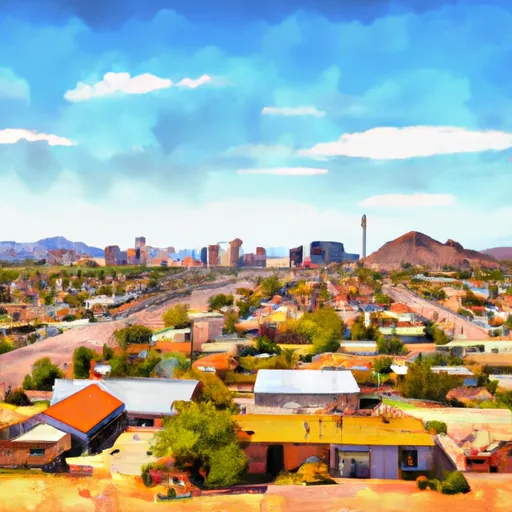-
 Snoflo Premium
Snoflo Premium
Get unlimited access to all our content
With no Ad interruptions! - Start Your Free Trial Login with existing account
Roosevelt
Eden Index
Climate
8.8
•
Recreation
8.9
•
Community
•
Safeguard
6.6/10

Roosevelt, Arizona is a small town situated in Gila County and is named after the nearby Theodore Roosevelt Lake. Known for its beautiful natural surroundings, Roosevelt has a semi-arid climate, characterized by hot summers and mild winters. Summers are typically dry and temperatures can reach above 100°F, while winters are cooler with temperatures averaging around 50°F.
Hydrologically, Roosevelt is located near Theodore Roosevelt Lake, which is Arizona's largest lake. The lake is formed by the Salt River and is a popular spot for boating, fishing, and water sports. The lake is also a part of the Salt River Project, a water management system that provides irrigation and drinking water to central Arizona.
Outdoor recreation opportunities in Roosevelt are abundant, thanks to its proximity to the Tonto National Forest. The forest offers various activities such as hiking, camping, mountain biking, and wildlife viewing. Visitors can explore the stunning desert landscape, scenic trails, and enjoy the peace and serenity of the surrounding wilderness. Overall, Roosevelt, Arizona is a destination that offers a diverse range of outdoor activities and a chance to connect with nature.
What is the Eden Index?
The Snoflo Eden Index serves as a comprehensive rating system for regions, evaluating their desirability through a holistic assessment of climate health, outdoor recreation opportunities, and natural disaster risk, acknowledging the profound impact of these factors on livability and well-being.
Climate Health Indicator (CHI): 8.8
Roosevelt receives approximately
349mm of rain per year,
with humidity levels near 46%
and air temperatures averaging around
20°C.
Roosevelt has a plant hardyness factor of
9, meaning
plants and agriculture in this region tend to thrive here all year round.
By considering the ideal temperature range, reliable water supplies, clean air, and stable seasonal rain or snowpacks, the Climate Health Indicator (CHI) underscores the significance of a healthy climate as the foundation for quality living.
A healthy climate is paramount for ensuring a high quality of life and livability in a region, fostering both physical well-being and environmental harmony. This can be characterized by ideal temperatures, reliable access to water supplies, clean air, and consistent seasonal rain or snowpacks.
Weather Forecast
Streamflow Conditions
Salt
Area Rivers
Salt
Snowpack Depths
Salt
Reservoir Storage Capacity
Salt
Groundwater Levels
Recreational Opportunity Index (ROI): 8.9
The Recreational Opportunity Index (ROI) recognizes the value of outdoor recreational options, such as parks, hiking trails, camping sites, and fishing spots, while acknowledging that climate plays a pivotal role in ensuring the comfort and consistency of these experiences.
Access to outdoor recreational opportunities, encompassing activities such as parks, hiking, camping, and fishing, is crucial for overall well-being, and the climate plays a pivotal role in enabling and enhancing these experiences, ensuring that individuals can engage in nature-based activities comfortably and consistently.
Camping Areas
| Campground | Campsites | Reservations | Toilets | Showers | Elevation |
|---|---|---|---|---|---|
| Schoolhouse | 211 | 2,192 ft | |||
| Burnt Corral | 13 | 1,940 ft | |||
| Sulphide Del Ray | 10 | 6,009 ft | |||
| Upper Burnt Corral | 30 | 1,951 ft | |||
| Pioneer Pass | 20 | 5,835 ft | |||
| Davis Wash | 30 | 1,972 ft | |||
| Windy Hill | 347 | 2,167 ft | |||
| Grapevine Bay | 40 | 2,309 ft | |||
| Pinal | 14 | 7,544 ft | |||
| Oak Flat | 16 | 3,942 ft |
Nearby Fishing
Catastrophe Safeguard Index (CSI):
The Catastrophe Safeguard Index (CSI) recognizes that natural disaster risk, encompassing floods, fires, hurricanes, and tornadoes, can drastically affect safety and the overall appeal of an area.
The level of natural disaster risk in a region significantly affects safety and the overall livability, with climate change amplifying these risks by potentially increasing the frequency and intensity of events like floods, fires, hurricanes, and tornadoes, thereby posing substantial challenges to community resilience and well-being.
Community Resilience Indicator (CRI):
The Community Resilience Indicator (CRI) recognizes that education, healthcare, and socioeconomics are crucial to the well-being of a region. The CRI acknowledges the profound impact of these elements on residents' overall quality of life. By evaluating educational resources, healthcare accessibility, and economic inclusivity, the index captures the essential aspects that contribute to a thriving community, fostering resident satisfaction, equity, and social cohesion.

